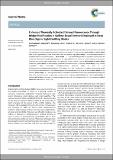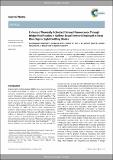Files in this item
Enhanced thermally activated delayed fluorescence through bridge modification in sulfone-based emitters employed in deep blue organic light-emitting diodes
Item metadata
| dc.contributor.author | Rajamallil, Pachaiyappan | |
| dc.contributor.author | Chen, Dongyang | |
| dc.contributor.author | Li, Wenbo | |
| dc.contributor.author | Cordes, David B. | |
| dc.contributor.author | Slawin, Alexandra | |
| dc.contributor.author | Samuel, Ifor D. W. | |
| dc.contributor.author | Zysman-Colman, Eli | |
| dc.date.accessioned | 2019-08-01T08:30:05Z | |
| dc.date.available | 2019-08-01T08:30:05Z | |
| dc.date.issued | 2019-06-14 | |
| dc.identifier | 258758639 | |
| dc.identifier | 4097eb2a-6233-48ba-a7c8-e76c66ee28b7 | |
| dc.identifier | 85066995949 | |
| dc.identifier | 000471064800017 | |
| dc.identifier.citation | Rajamallil , P , Chen , D , Li , W , Cordes , D B , Slawin , A , Samuel , I D W & Zysman-Colman , E 2019 , ' Enhanced thermally activated delayed fluorescence through bridge modification in sulfone-based emitters employed in deep blue organic light-emitting diodes ' , Journal of Materials Chemistry C , vol. 7 , no. 22 , pp. 6664-6671 . https://doi.org/10.1039/C9TC01498E | en |
| dc.identifier.issn | 2050-7526 | |
| dc.identifier.other | ORCID: /0000-0002-9527-6418/work/58755457 | |
| dc.identifier.other | ORCID: /0000-0002-5366-9168/work/58755463 | |
| dc.identifier.other | ORCID: /0000-0001-7183-6022/work/58755505 | |
| dc.identifier.other | ORCID: /0000-0001-8079-0425/work/60196827 | |
| dc.identifier.uri | https://hdl.handle.net/10023/18227 | |
| dc.description | The authors are grateful to the Engineering and Physical Sciences Research Council (EPSRC) for support from grants EP/P010482/1 and EP/R035164/1. P. Rajamalli acknowledges support from a Marie Skłodowska-Curie Individual Fellowship (MCIF; No. 749557). Dongyang Chen and Wenbo Li thank the China Scholarship Council (grant numbers 201603780001 and 201708060003). | en |
| dc.description.abstract | Two thermally activated delayed fluorescence (TADF) emitters bearing a new dipyridyl sulfone core as the electron-accepting unit and di-tert-butyl carbazoles as electron-donating units are reported. The two emitters, pDTCz-2DPyS and pDTCz-3DPyS , differ in the regiochemistry of the substitution about the pyridine rings [ pDTCz-2DPyS = 9,9'-(sulfonylbis(pyridine-6,3- diyl))bis(3,6-di-tert-butyl-9H-carbazole); pDTCz-3DPyS = 9,9'-(sulfonylbis(pyridine-5,2-diyl))bis(3,6-di-tert-butyl-9H- carbazole)]. Both compounds show blue emission in the range of 450-465 nm, which is in line with theoretical calculations. They have very similar singlet-triplet energy (ΔEST) gaps (ΔEST = 0.22 eV and 0.21 eV for pDTCz-3DPyS and pDTCz-2DPyS , respectively). pDTCz-2DPyS has a much larger proportion of delayed emission (26.2%) than pDTCz-3DPyS (1.2%)]. The two compounds show comparable photoluminescence quantum yields of 60% in 2,8- bis(diphenylphosphoryl)dibenzo[b,d]thiophene (PPT) doped films. The performance of organic light-emitting diodes (OLEDs) depends on the host used. The maximum external quantum efficiency (EQE) in the PPT host of pDTCz-3DPyS is 7.0%, whilst for pDTCz-2DPyS it is 12.4%. High performance is obtained for both materials when bis[2-(diphenylphosphino)phenyl] ether oxide (DPEPO) is used as the host, with a maximum EQE of 13.4% for pDTCz-3DPyS and 11.4% for pDTCz-2DPyS . In addition, pDTCz-3DPyS shows pure blue electroluminescence with CIE color coordinates of (0.15, 0.12) compared to pDTCz- 2DPyS with coordinates of (0.15, 0.19). | |
| dc.format.extent | 1775240 | |
| dc.format.extent | 1801683 | |
| dc.language.iso | eng | |
| dc.relation.ispartof | Journal of Materials Chemistry C | en |
| dc.subject | QD Chemistry | en |
| dc.subject | DAS | en |
| dc.subject.lcc | QD | en |
| dc.title | Enhanced thermally activated delayed fluorescence through bridge modification in sulfone-based emitters employed in deep blue organic light-emitting diodes | en |
| dc.type | Journal article | en |
| dc.contributor.sponsor | EPSRC | en |
| dc.contributor.sponsor | EPSRC | en |
| dc.contributor.sponsor | European Commission | en |
| dc.contributor.sponsor | EPSRC | en |
| dc.contributor.institution | University of St Andrews. School of Physics and Astronomy | en |
| dc.contributor.institution | University of St Andrews. School of Chemistry | en |
| dc.contributor.institution | University of St Andrews. Organic Semiconductor Centre | en |
| dc.contributor.institution | University of St Andrews. EaSTCHEM | en |
| dc.contributor.institution | University of St Andrews. Centre for Biophotonics | en |
| dc.contributor.institution | University of St Andrews. Condensed Matter Physics | en |
| dc.identifier.doi | https://doi.org/10.1039/C9TC01498E | |
| dc.description.status | Peer reviewed | en |
| dc.date.embargoedUntil | 2020-04-23 | |
| dc.identifier.grantnumber | EP/P010482/1 | en |
| dc.identifier.grantnumber | EP/R035164/1 | en |
| dc.identifier.grantnumber | 749557 | en |
| dc.identifier.grantnumber | EP/P010482/1 | en |
This item appears in the following Collection(s)
Items in the St Andrews Research Repository are protected by copyright, with all rights reserved, unless otherwise indicated.


